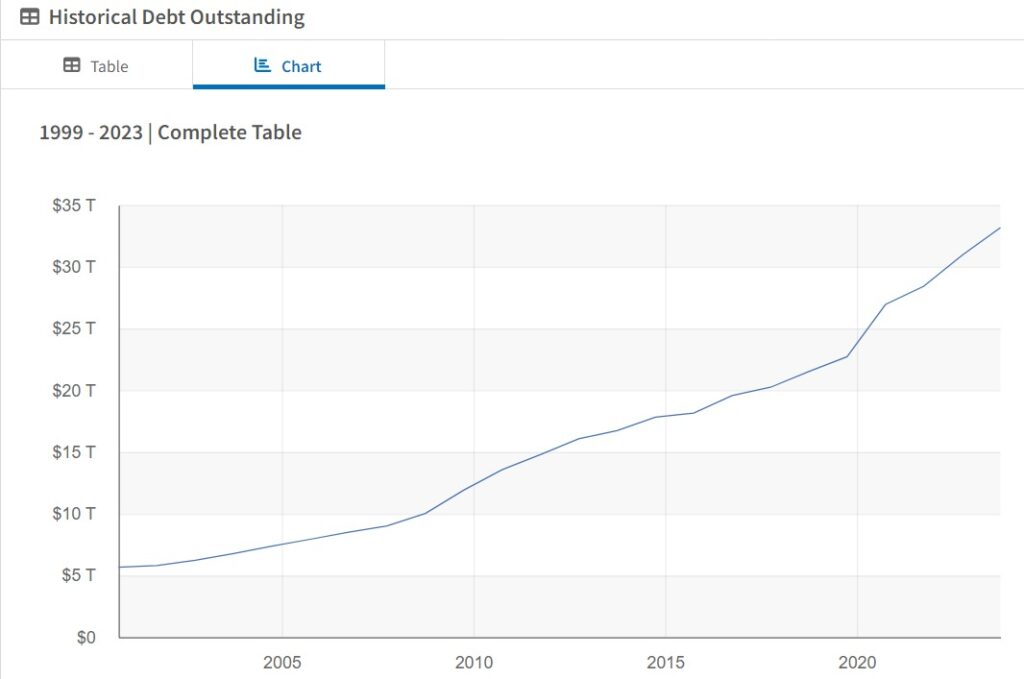It’s a number that sends shivers down the spines of economists and average citizens alike: US National Debt $34 trillion. That’s the new staggering height of the US national debt, a figure so colossal it’s hard to wrap your head around. But while the details might seem far removed from our daily lives, the reality is, that this mountainous debt casts a long shadow on every American’s future.

This isn’t just about dry numbers on a spreadsheet. This debt represents the accumulated borrowing by the US government over its entire history. Every penny spent beyond what it collects in taxes adds another brick to this ever-growing wall. And like any towering debt, it comes with a hefty price tag, one that affects our wallets, our economy, and even our national security.
US National Debt A Ticking Time Bomb for Your Wallet:
Imagine paying interest on a credit card bill that never seems to shrink. That’s essentially what’s happening with the national debt. As the debt grows, so does the amount we owe in interest payments. In 2023, the government spent a staggering $2 billion every single day just on interest! That’s money that could be going towards crucial areas like education, healthcare, and infrastructure – investments that benefit every citizen.
Also Read: Highest Debt to GDP Ratio Countrywise
US National Debt History
The US national debt has been on a steady upward climb since the country’s founding, but it has especially ballooned in recent decades.
- In 1790, the debt was just $80 million.
- By 1945, at the end of World War II, it had soared to $266 billion.
- In 2000, it stood at $5.6 trillion.
- And as of December 29, 2023, it has surpassed $34 trillion.
- In the Last 10 Years, It has been doubled from $17 trillion to $34 trillion.

Source: Treasury Website
Several factors have contributed to this dramatic increase:
- Wars: The United States has fought many wars throughout its history, and these wars have always been expensive. The Civil War, World War I, World War II, the Korean War, the Vietnam War, the Iraq War, and the War in Afghanistan have all added to the national debt.
- Tax cuts: The federal government has enacted a number of tax cuts in recent years, which have reduced its revenue and increased the national debt. The most recent major tax cuts were passed in 2017 during the Trump administration.
- Entitlement programs: The United States has a number of entitlement programs, such as Social Security and Medicare, which provide benefits to millions of Americans. These programs are funded by payroll taxes, but the cost of these programs has been growing faster than the revenue from payroll taxes, which has added to the national debt.
- Other factors: Other factors that have contributed to the national debt include the Great Recession of 2008-2009, the COVID-19 pandemic, and natural disasters.
The national debt is a complex issue with no easy solutions. There is no consensus among economists on how to address the debt, and there are a variety of proposals that have been put forward. Some possible solutions include raising taxes, cutting spending, reforming entitlement programs, and economic growth.
It is important to note that the national debt is not all bad. Some economists argue that a certain level of debt is necessary for a healthy economy. However, the current level of debt is unsustainable in the long term, and it is important to take steps to address it.
US National Debt Squeezing the Economic Lifeline:
Think of the national debt as a giant vacuum sucking money out of the economy. The more we borrow, the less is available for businesses to invest and create jobs, potentially leading to slower economic growth and fewer opportunities for all. This trickle-down effect can mean stagnant wages, higher prices, and a generally bleaker economic outlook for everyone.
US National Debt National Security Concerns:
Beyond the economic impact, the debt also puts a strain on our national security. A country heavily in debt is seen as less stable and reliable on the global stage. This can weaken our alliances, embolden our adversaries, and limit our ability to respond to international crises. It’s like carrying a heavy backpack on a hike – you become less agile and more vulnerable to threats.
So, where do we go from here?
The political bickering and finger-pointing won’t solve this problem. We need real solutions, and that means a collective effort. Some potential paths forward include:
- Responsible Spending: The government needs to prioritize spending on critical areas like infrastructure and education while carefully evaluating less essential programs.
- Tax Reform: A fair and efficient tax system can generate more revenue without overburdening taxpayers.
- Bipartisan Collaboration: This issue transcends party lines. Both Democrats and Republicans need to come together and find common ground for sustainable solutions.
- Individual Awareness: Understanding the impact of the debt on our own lives can empower us to hold our elected officials accountable and demand responsible fiscal policies.
The $34 trillion debt may seem like a daunting mountain, but remember, mountains are climbed one step at a time. By acknowledging the gravity of the situation, demanding responsible action from our leaders, and making informed choices as individuals, we can begin to chip away at this burden and build a brighter future for ourselves and the generations to come.
This is not just about numbers on a page; it’s about the future of our nation, our economy, and our families. Let’s be informed, engaged, and proactive in tackling this challenge together. The time to act is now.
Remember, the fate of our future is not set in stone. We have the power to chart a different course, one where shared responsibility and fiscal prudence pave the way for a more secure and prosperous America.
